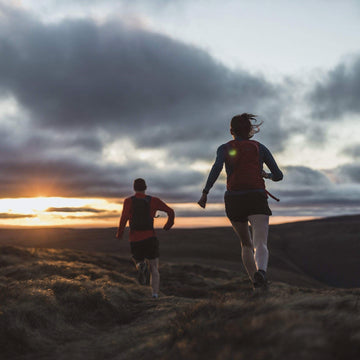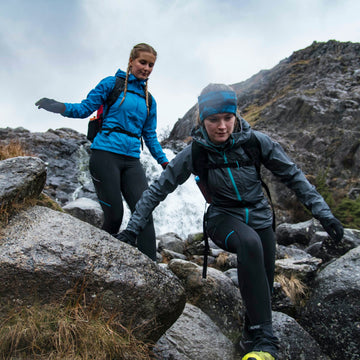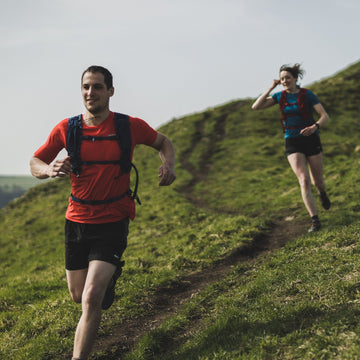
Using low heart rate training to combat stress and build sustainable endurance fitness. Discover benefits of this training approach for outdoor athletes.
We runners have long known the therapeutic effects of lacing up our trainers and hitting the trails, blasting away the day’s worries by getting the heart rate souring and the adrenaline pumping. We return home calmer, energised and more resilient.
Whilst there is no doubt that you normally feel better immediately after a workout, there are plenty of experienced runners who continue to suffer high levels of stress and anxiety despite all the miles they clock up. Why are those immediate feelings of well-being not lasting or worse, not happening at all during times when we’re under pressure?
It’s a classic scenario. You feel anxious, you run, you feel better, so you do it some more. In times of extreme stress, you may come to rely on the endorphin boost so much that you increase your training volume or intensity way too fast. Whilst your body will often let you get away with it for a couple of weeks, chances are it will eventually catch up with you in the form of injuries and the last thing you need at times like these is to have to stop running altogether whilst you recover.
But if running is the thing that’s keeping us sane right now, how can we enjoy all those stress-beating benefits without risking injury and burnout? It might be that, in order to stop your overall stress levels getting out of control, you need to reduce the intensity of your training for a while in order to make room for the other, unavoidable pressures. One way of doing this is by using low heart rate training.

Dr Phillip Maffetone, in ‘The Big Book of Endurance Training and Racing’, explains that our bodies experience three different types of stress; mental and emotional stress, chemical stress (from things like unhealthy eating, taking certain medicines or air pollution) and finally physical stress from taxing our bodies through exercise. When we say we feel ‘stressed’, we tend to focus on the former, but the human body actually can’t distinguish between the three and the end result is the same, whether you’re having a crisis at work, living on junk food or upping your training too fast.
Whilst in an ideal world, we’d make changes to reduce every type of stress, the reality for many is that there’s only so much we can do to address the first two kinds. Sure, we can try to eat more healthily and avoid running in especially polluted areas, but when you’re stuck in a toxic cycle of anxiety from work/health/family/money worries, it’s easy to feel powerless to make changes.
What we can control however, is how much stress we put on our bodies during training. If we can dial back the pressure from even one of the three stress types, our overall level of stress will reduce, and the effects can be quite powerful.
So, what do you have to do? An easy way to start is to visit Dr Maffetone’s website and download his free e-book. A condensed version of the ‘Big Book’, it tells you how to work out your own, personalised aerobic training zone. The idea is that if you stick within this training zone, you will not only build your aerobic base but also take a whole heap of pressure off your body (both in terms of overall stress levels and specific stresses on bones, muscles and joints).
I started using this technique back in March last year in an effort to overcome a series of minor injuries. It’s a steep learning curve and for most, the first few weeks of training will feel extremely slow as you will likely find your prescribed heart rate zone much lower than you are used to. Stick with it though, and you’ll find your pace does start to return but at the new, vastly reduced heart rate.
After 6 months of low heart rate training, the benefits were tangible. I was expecting to feel less sore, tired and injured and indeed, I found that I could now run non-stop for 90 minutes with no soreness (during or after) whatsoever. After a few months, this increased to 2.5 hours which, considering an hour at my old heart rate would often leave me feeling seized up, is incredible.

There were other benefits though, that I wasn’t expecting and it is these that will help if you are looking for a way to feel less stressed. Training at a level that wasn’t taxing my body so much made me feel happier and more energised during my runs and made me look forward to my training sessions much more than before. Corny as it sounds, you do start to look around you and ‘smell the roses’ when you’re not head-down, powering up hills and gasping for breath. The sense of increased mental wellbeing was noticeable, not only during runs but in the hours/days that followed too. I was also able to safely increase my volume over the months, going from 5 to 10+ hours per week without hurting my body at all. This in turn, helped reduce stress levels further as I was outside, getting exercise literally twice as much of the time as before.
The initial slower pace does take a little getting used to, especially if you’ve always associated pushing hard with your ‘runner’s high’. However, it doesn’t take long before you are rewarded with something different; a ‘runner’s calm’ and right now, that might be exactly what you need. It’s doesn’t mean that you will go through life feeling zero pressure; at the moment that’s probably unrealistic for the majority of us. What it may do, however, is knock the edge off enough for you to feel a little more in control; a little more positive in these uniquely worrying times. If you are feeling the pressure right now, there are certainly worse things you could do then give this a try.
For further reading, try ‘The Big Book of Endurance Training and Racing’ by Dr Phillip Maffetone, ‘80/20 Running: Run Stronger and Race Faster’ by Matt Fitzgerald and ‘Training for the Uphill Athlete’ by Steve House, Scott Johnston and Kilian Jornet’.









